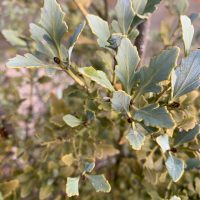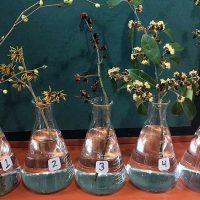Preserving Australian Flora in the Washington Park Arboretum

The Pacific Connections Garden (PCG), found at the southern end of the Arboretum, is a place that spurs the floristic imagination. Visitors traverse hemispheres and continents while moseying through gardens that showcase plant communities from specific regions in New Zealand, China, Cascadia, Chile, and Australia. In a short walk it’s possible to pass through our version of the New Zealand high country, continue on to the Cascadia garden, featuring plants native to the Siskiyou mountains, and finish with our representation of the wine palm and monkey puzzle laden temperate rainforests of Southern Chile.
Read moreSelected Cuttings from the Home of Joanna Long, Pacific Connections Horticulturist

Native Ground Covers in Bloom
1) Trillium ovatum Pacific Trillium
The three white petals of Trillium are always a sign of spring. As they age, the petals turn pink.
These native wildflowers are common under-story plants in our woods.
The seeds of Trillium contain a substance attractive to ants who act as seed dispersers.
Scattered populations of Trillium bloom throughout the native areas of the Arboretum.
Selected Cuttings from the Home of Roy Farrow, WA Park Arboretum Grounds Supervisor

1) Acer palmatum ‘Katsura’ Japanese Maple
Japanese maples have been cultivated in Japan for over 300 years. While they are most known for their stunning fall colors, I personally enjoy them as much in the spring for their new leaf color.
‘Katsura’ is a cultivar which appears to have bright orange new leaves, but on closer inspection, the leaves are bright yellow with a red margin.
April 2020 Plant Profile: Magnolia ernestii
-200x200.jpg)
Magnolias, magnolias, magnolias! Where to begin?! These harbingers of spring have started to bloom! The Washington Park Arboretum has 250 magnolia tree specimens, with some impressively mature trees dating back to 1940. Lucky for us, the breadth and variety of the University of Washington Botanic Gardens’ collection means we should have a steady supply of magnolia blooms through the summer.
Of the 250 magnolia specimens, there are 38 species, subspecies and varieties (i.e.
Spring Transition at the Washington Park Arboretum

1) Cornus mas Cornelian Cherry
This yellow flowering tree that blooms in late winter to early spring, is native to southern Europe and southwestern Asia.
The common name refers to the fruit that matures in late summer. The fruit has many cultural uses including jams, medicine, beverages, tools, and spears.
There is a grove of this Cornus at the Center for Urban Horticulture along NE 41st Street.
Arriba for Azaras!

Azara is a genus of plants native to the temperate and subtropical regions of South America. The Chilean name for these plants is Corcolén. The genus contains only ten species, four of which you can find growing here at the Washington Park Arboretum! All species of Azara are evergreen shrubs to small trees. Although some species of Azara are considered to be borderline hardy in our Pacific Northwest climate, we have had success growing them at the Arboretum.
Read moreOur 2020 Northwest Flower and Garden Festival Display: “Gateway to a Greener Earth”

The following ex-situ conservation plants are all listed as endangered in their region of origin due to habitat loss and climate change:
1) Araucaria araucana Monkey Puzzle
This unique looking conifer is native to the Chilean Andes and considered a living fossil dating back over 60 million years.
The Mapuche Pehuenche people of the Andes value these trees for their edible seeds and spiritual significance.
All About Hamamelidaceae: The Witch Hazel Family

1) Corylopsis glabrescens Fragrant Winter Hazel
Corylopsis are Asian natives which bloom in late winter or early spring with profusions of sunny yellow flowers dangling from bare branches.
Corylopsis glabrescens is the hardiest of the genus and can grow up to 15 feet high and wide.
Flower buds are about to burst open on this shrub in the Witt Winter Garden.
Selected Cuttings from the Washington Park Arboretum

1) Abies pinsapo var. marocana
This fir is native to Morocco, where it occupies a small area in the mountains south of Tetuan.
Not as tall as the type, this variety has needles similar to A. pinsapo but are wider and longer.
Located along the Arboretum Loop Trail, just south of parking lot #19.
2) Cunninghamia konishii
Cunninghamia is a genus of just three species native to northeastern Asia.
Read moreJanuary 2020 Plant Profile: Trees with Ornamental Bark

As we approach winter and the leaves are off the deciduous trees, we have an opportunity to see the forms of trees and their bark. Some tree barks are just gorgeous and really add to a landscape’s appeal.
Read more